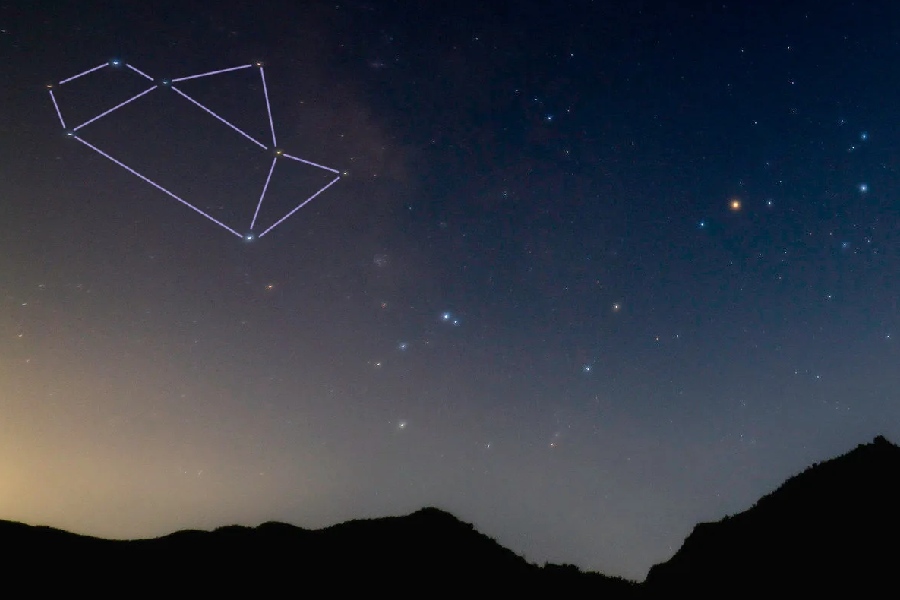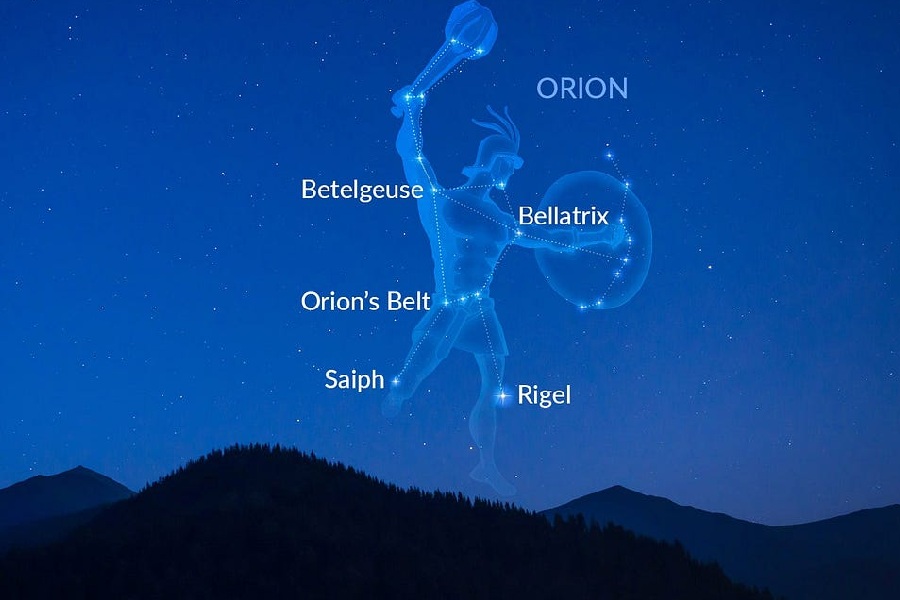An asterism is a pattern of stars that is not part of any official constellation but is recognized as a distinct grouping. Many of them have intriguing shapes, meanings, and mythologies. But what stories lie within a comprehensive list of asterisms, and how do these celestial formations enrich our understanding of the night sky?
In this article, we will explore the most known asterisms and their backstories. We’ll uncover how various cultures made pictures in the stars and wove imaginative tales around them over the ages. From ancient times up through modern astronomy, the night sky has inspired people to connect the dots of stars in whimsical ways.

List of Asterisms
Asterisms, which are distinct star patterns within constellations, might not hold official constellation status. Examples of common asterisms include the Big Dipper, a part of Ursa Major, the Summer Triangle formed by three bright stars from different constellations, and the Teapot, a component of Sagittarius.
But how many asterisms are there? Astronomers and the International Astronomical Union officially recognize 88 star patterns, referred to as constellations. These patterns, with cultural and historical importance, are frequently employed for stargazing and navigation.
Although there isn’t a comprehensive list of asterisms, various cultures throughout history have observed and named these patterns. This fosters a connection to the night sky.
5 Famous Asterisms
The Big Dipper (Ursa Major)
The Big Dipper asterism is composed of seven bright stars that form a distinctive ladle-like shape. The bowl of the Big Dipper contains four stars – Dubhe, Merak, Phecda, and Megrez. Dubhe and Merak are known as the “Pointer Stars” directed toward Polaris.
The handle is formed by three stars – Alioth, Mizar, and Alkaid. Mizar itself is a binary star system. The entire shape of the Big Dipper is located in the northern section of the sky.
Cultural significance
The easily recognizable shape of the Big Dipper has made it culturally significant across ancient civilizations. Native American cultures envisioned the shape as a bear, while the Chinese saw it as a chariot.
The Big Dipper has also been associated with religious symbols and cosmic mythology. Its usefulness in navigation for finding the North Star (Polaris) and locating directions has interwoven it into the history of travel and journeys. People have woven imaginative cultural stories around it for ages.
Role in navigation
The two Pointer Stars in the bowl of the Big Dipper, Dubhe and Merak, direct towards Polaris, which lies fairly close to the north celestial pole. This makes the Big Dipper asterism uniquely useful for navigation to locate the North Star and determine which direction is north.
Travelers and explorers have historically used the Big Dipper for wayfinding and orientation across land and sea. Even in modern transportation, the Big Dipper continues to guide a navigation aid for determining latitude and heading.
Pleiades (Seven Sisters)
The Pleiades star cluster, also called Seven Sisters, is a tiny grouping of hot blue stars surrounded by nebulosity or dust clouds. To the naked eye, Pleiades resembles a tiny dipper or ladle shape loosely composed of six or seven visible stars.
With telescopes, dozens more stars are resolvable, along with glowing nebulosity. The stars appear tightly clustered with strands connecting them, around 0.8 light years across. The brightest stars are blue giants, several times the sun’s mass and luminosity.
Cultural significance
The striking appearance of the Pleiades cluster has inspired many cultural legends and lore across civilizations. In Greek mythology, the seven daughters of Atlas and Pleione were turned into stars after death.
Indigenous peoples, like the Kiowa tribe or Australian Aboriginals, have stories about lost sisters or ancestral women. The Pleiades cluster has been celebrated in art, books like Tennyson’s poetry, Japanese Subaru symbols, and many films.
Attributes in astronomy
The Pleiades’ hot blue stars and glowing pink nebulosity make it ideal for astronomical observations. It allows astronomers to study star formation processes and the interstellar medium.
Imaging the delicate threads of dust also informs cosmological models. Its brightness and ease of location have also made it immensely popular in amateur astronomy and astrophotography pursuits.

Orion’s Belt
Orion’s Belt comprises three bright stars quite close together: Alnitak, Alnilam, and Mintaka. They form a short straight row located in the famous Orion constellation.
Orion’s Belt lies close to the celestial equator in a region dense with gas and dust, with active star formation happening. It is one of the night sky’s most easily spotted star patterns.
Mythological associations
The three stars of Orion’s Belt have been associated with various mythological tales and lore across human cultures. Ancient Egyptians associated it with the Object of Osiris. Some myths hypothesized that Orion’s Belt and Sword stars correlated with weather patterns or rain.
Furthermore, Indigenous cultures like the Pawnee visualized the belt as raccoon tracks or other animals/people in Orion’s figure. Moderns envision tools like a sword scabbard, rope belt, or power belt on a superhero costume.
Kemble’s Cascade
Kemble’s Cascade is an asterism located next to the Cassiopeia constellation with a visually striking “waterfall” shape. It consists of a long chain of faint stars that appear to cascade downwards through space.
The cascade pattern is distinctive, with no other comparable star chains visible. It lies partially obscured behind swaths of cosmic dust. Though visible to the naked eye under dark skies, it is better spotted with binoculars.
Significance to stargazers
Kemble’s Cascade’s unique shape makes it visually appealing to observe for amateur astronomers. It lies in a circumpolar region of the northern sky, making it continuously observable. Though the stars themselves are dim, the shape itself is noticeable.
It can be spotted even in moderately light-polluted suburbs, not just dark rural skies. These qualities make Kemble’s Cascade popular for amateur astrophotography compositions and enjoyed by casual stargazers alike.
Zeta Ori and Zeta Aur
Zeta Ori denotes the easternmost star, marking Orion’s upraised arm holding a shield. Though faint at visual magnitude 3.0, it completes Orion’s figural shape along with Betelgeuse and Bellatrix.
Zeta Aur marks the northwestern tip star of Auriga, the Charioteer asterism, outlining one rein of its pentagon shape. Though only magnitude 2.6, it lies near brilliant Capella, which betrays its presence.
While themselves dim, Zeta Orionis and Zeta Aurigae hold cultural meaning by outlining these two prominent constellations in the winter sky. Stargazers often use them as guideposts to star-hop between Orion, Auriga, and the California Nebula region.
Interesting Facts About Asterisms
Practical use in navigation
For centuries, asterisms have played a crucial role in navigation. Sailors relied on Orion’s Belt to steer during the night, while Chinese sailors found guidance in the Big Dipper.
Similarly, Bedouins used the false Pleiades to navigate deserts. The link between asterisms and stars was a valuable tool in determining time, location, and direction.
Symbolic roles in mythology
Asterisms play a significant role in cultural mythologies worldwide. In Native American traditions, stories revolved around the spirit animals.
Meanwhile, myths associated with the Big Dipper cover many themes, including cosmic eggs, plows, grain, dimensions, and bears. These tales often connect to gods, weather patterns, harvests, or moral lessons. The influence of asterisms on symbolic storytelling is evident across diverse civilizations.
Visibility to the naked eye
Unlike faint constellations, bright asterisms are visible to the naked eye. Their stars can be hundreds of times brighter than threshold visibility.
This wider accessibility enabled more imaginative cultural connections. From urban backyards to ancient deserts, asterisms’ visibility made them impactful sky symbols.
Differing interpretations
The patterned stars of asterisms have sparked various symbolic interpretations. For instance, Orion’s Belt is seen as Osiris’s phallus, while the Pawnee’s raccoon tracks present a different perspective.
As mentioned, some view the Big Dipper as a wagon, while others see it as a saxophone. The accessibility and ambiguity of asterisms have enabled diverse and innovative cultural perspectives to emerge.
Storytelling traditions
Globally, renowned asterisms are steeped in rich oral traditions. In Australia, Aboriginal stories weave captivating tales of the Emu in the Sky. The Iroquois, envisioning the Big Dipper’s Bowl as a mighty bear, and Tibetan myths recounting the exploits of ancient kings contribute to this global tapestry of storytelling. Across diverse epochs and cultures, the allure of asterisms has sparked and enriched vibrant storytelling traditions.
Conclusion
In this exploration of the list of Asterisms, we hope people gained an appreciation for these stellar splendors beyond just the scientific. From navigational aids for ancient mariners to vehicles of the imagination across cultures, asterisms have played many roles.
Orion’s Belt, Ursa Major, Pleiades and more have sparked symbolic stories and differing interpretations across civilizations. Yet they bind humanity in their accessibility to all.
Their visibility unaided makes them democratic symbols that have inspired rich cultural traditions and brought the heavens closer across geography and time. As new generations gaze up at these star patterns glittering overhead, may the dreams and epics of their ancestors shine through.
